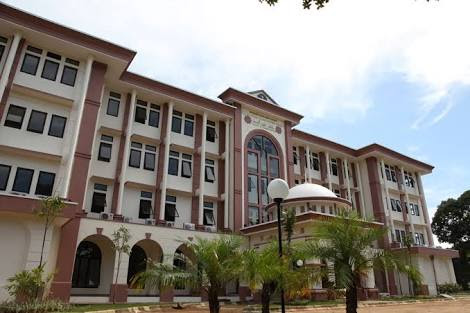THE EFFECT OF VIRTUAL LEARNING THROUGH ONLINE LEARNING SYSTEM (SPADA) ON STUDENTS' LEARNING OUTCOMES IN ALGEBRAIC STRUCTURE COURSE IN DEPARTMENT OF MATHEMATICS EDUCATION, MUHAMMADIYAH UNIVERSITY OF MAKASSAR
Abstract
This study aims to determine the effect of treatment on student learning outcomes in the algebraic structure course at the Department of Mathematics Education of the University of Muhammadiyah Makassar in virtual learning through the online learning system (SPADA). This study is a quasi-experimental design with a post-test-only control group whose results were analyzed using descriptive analysis and inferential analysis (mann whitney test). The population is the class of 2019 who is programming an algebraic structure course consisting of 3 classes, then a sample consisting of 2 classes was selected, namely, one experimental class taught through SPADA, and one control class taught in addition to using SPADA, namely, zoom meeting, google meet, email, and whatsApp groups. The instrument used is a test of student learning outcomes. The results obtained are that the average learning outcomes of students who are taught through SPADA are higher than the average learning outcomes of students who are taught other than through SPADA, but the results of the Mann Whitney test show that there is no significant difference from the learning outcomes of students who have been taught through SPADA or other than SPADA. Researchers suggest that providing virtual learning not only relies on one learning media but also on the synergy between one media and another, which will further optimize virtual learning.
Downloads
References
Becker, S., Klein, P., Gossling, A., & Kuhn, J. (2020). Using mobile devices to enhance inquiry-based learning processes. Learning and Instruction, 69(June), 101350. https://doi.org/10.1016/j.learninstruc.2020.101350.
Damayanti, S. P. L. S. (2020). Implementasi E-learning dalam pembelajaran bahasa inggris di pendidikan tinggi pariwisata di Bali selama pandemi covid-19. Journey (Journal of Tourismpreneurship, Culinary, Hospitality, Convention and Event Management), 2(2), 63–82. Retrieved from http://www.ojs-journey.pib.ac.id/index.php/art/article/view/48.
Haqien, D., & Rahman, A. A. (2020). Pemanfaatan zoom meeting untuk proses pembelajaran pada masa pandemi covid-19. SAP (Susunan Artikel Pendidikan), 5(1). https://doi.org/10.30998/sap.v5i1.6511.
Hartono, A. B., Tinungki, G. M., Hartono, P. G., Simanjuntak, R., & Muchtar, S. (2021). E-learning based mathematics learning media : an empirical study on operations research in the covid-19 Pandemic in Makassar City of Indonesia. 550(Icmmed 2020), 434–441.
Hudha, M. N., Chaeruman, U. A., Aji, S. D., Huda, C., Yusro, A. C., Kumala, F. N., Wartono, W., Nandiyanto, A. B. D., & Abdullah, A. G. (2018). SPADA: Online learning between universities of PGRI Indonesia. MATEC Web of Conferences, 197, 1–6. https://doi.org/10.1051/matecconf/201819703002.
Ilmiyah, N. H., & Sumbawati, M. S. (2019). Pengaruh media kahoot dan motivasi belajar terhadap hasil belajar siswa. In Journal Information Engineering and Educational Technology (Vol. 3, Issue 1, pp. 46–50).
Khairani, N. A., Rajagukguk, J., & Derlina. (2020). Development of moodle e-learning media in industrial revolution 4.0 era. 384(Aisteel), 752–758. https://doi.org/10.2991/aisteel-19.2019.172.
Leonard, I. M. (2013). Kajian penerapan e-learning dalam proses. Faktor Exacta, 6(4), 278–289. Retrieved from https://journal.lppmunindra.ac.id/index. php/Faktor_Exacta/article/view/239.
Mosa, A. A., Naz’ri bin Mahrin, M., & Ibrrahim, R. (2016). Technological Aspects of E-Learning Readiness in Higher Education: A Review of the Literature. Computer and Information Science, 9(1), 113. https://doi.org/10.5539/cis.v9n1p113.
Pangondian, R. A., Santosa, P. I., & Nugroho, E. (2019). Faktor-faktor yang mempengaruhi kesuksesan pembelajaran daring dalam revolusi industri 4.0. Sainteks 2019, 56–60. Retrieved from https://seminar-id.com/semnas-sainteks2019.html.
Rahmawati, R. (2017). Penerapan Pembelajaran Blended Pada Mata Kuliah Fisiologi Tumbuhan. JESBIO: Jurnal Edukasi Dan Sains Biologi, 6(2), 23. Retrieved from http://jfkip.umuslim.ac.id/index.php/jesbio/article/view/325.
Sakkir, G., Dollah, S., & Ahmad, J. (2021). E-learning in covid-19 situation: students’ perception. EduLine: Journal of Education and Learning Innovation, 1(1), 9–15. https://doi.org/10.35877/454ri.eduline378.
Santoso, H. A., & Istiqomah, N. R. (2021). The Implementation of using quizizz and g-form during the covid-19 pandemic based on students’ attitude. MaPan, 9(1), 14. https://doi.org/10.24252/mapan.2021v9n1a2.
Setiawan, R., Mardapi, D., Pratama, A., & Ramadan, S. (2019). Efektivitas blended learning dalam inovasi pendidikan era industri 4.0 pada mata kuliah teori tes klasik. Jurnal Inovasi Teknologi Pendidikan, 6(2), 148–158. https://doi.org/10.21831/jitp.v6i2.27259.
Wijayanti, M., Yunita, T., & Dharmanto, A. (2020). Pembelajaran perguruan tinggi dalam jaringan (daring) masa pandemi covid-19. Jurnal Kajian Ilmiah, 1(1), 31–38. https://doi.org/10.31599/jki.v1i1.268.
Copyright (c) 2021 St Nur Humairah Halim, Sitti Rahmah Tahir, Randy Saputra Mahmud, Ilham Syata, Dwi Novitasari

This work is licensed under a Creative Commons Attribution 4.0 International License.

